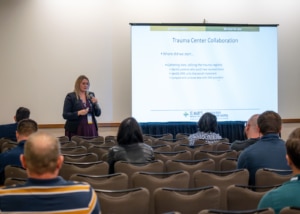Wave 2024 Recap: Top 5 Key Topics in the Hospital Industry
From April 2-5, ESO brought the hospital industry’s top thought leaders and data analysts together at Wave 2024 to share what trends they’re forecasting for the medical field along with how they’re enacting change within their own organization through the power of data-driven insights. Throughout the four-day conference, many impactful topics were discussed, and five major themes emerged.

1. Strengthening team and employee morale
Demanding in its nature while also being in a perpetual state of flux, the hospital industry can be taxing both physically and mentally. Putting the wellbeing and mental health of care providers on the forefront should be a priority for organizations, especially during seasons of change. The Stethoscope and the Spreadsheet: Balancing Leadership Business Skills by Shawntay Harris, DNP, MBA, MHA, RN, FAEN, President and CEO, Eminent Healthcare Resources Consultants, Inc., gave insights into how to combine clinical expertise with business acumen to successfully lead your team through improvements or changes to current procedures. Then in another session also presented by Harris, Passing the Baton: Ensuring Smooth Leadership Transitions, the importance of a well-executed succession plan in ensuring the happiness and wellbeing of your entire team during periods of leadership transitions was discussed. But we all know that it isn’t just in periods of transition where leadership matters, having the right person in place heading the team can make a huge difference with team members that can prove challenging. The Only Person Who Likes Change is a Wet Baby by Mike Taigman, Improvement Guide, FirstWatch addressed this by looking at data-driven leadership through the lens of “difficult employees” and the neurology of stress. He dove into why these employees can be difficult, how they struggle, how to improve relationships with them, and what you can do to turn them into your greatest asset.
2. Improving patient outcomes through data
Unsurprisingly, data was a major discussion point at a data-driven conference. While most of the discourse in this four-day event surrounded the topic, How to be Unpopular: Start Asking if Trauma Data Processes are Ready for An Overhaul by Heidi Hotz, RN, Director, Trauma-Emergency General Surgery-Surgical Critical Care Programs, Cedars-Sinai Medical Center made the point that it isn’t enough for us to utilize our data, but we also need to continue to explore the gaps in our current data processes and work to improve them. Hotz went on to discuss the importance of breaking away from traditional methods and pushing towards more contemporary models of data retrieval and analysis so the industry can continue to see growth and optimize outcomes.
In another talk, The 2023 ESO Trauma Index: Benchmarking Quality Improvement for National Standards in Trauma Care by Garrett Hall, MS, BSN, RN, CSTR, CAISS, Sr. Director of Hospital Programs, ESO, we learned how aggregate data is an incredibly powerful tool for quality improvement and aligning organizations from around the country in their standards of care. The conversation surrounded the ESO 2023 Trauma Index and how it helped to create national benchmarks around important metrics through insights gained from a year’s worth of deidentified data collected from nearly 600 participating facilities. If you’re interested in taking a look at the Trauma Index to see how your organization compares to the national standard in important areas such as time to administration of antibiotics for trauma patients with open long bone fractures and percentage of penetrating trauma victims having a systolic blood pressure (SBP) less than 90 mmHg or shock index (SI) greater than one, you can check out it out here.

3. Technological advancements in rural healthcare
As technology continues to advance, we are no longer limited to providing care in hospital environments, which allows greater access to previously underserved populations, especially those in rural communities. For Eagle County Paramedic Services, turning to mobile integrated healthcare was integral to helping them provide services for their underserved while also saving millions in costs. Their Wave session, Putting the “I” in Mobile Integrated Healthcare; Measuring system-wide outcomes and Cost Savings by Alice Harvey, MSN, BSN, RN, CP-C, Community Health Manager, Eagle County Paramedic Services was one of many that spoke to how this new model of care is game-changing in a post-pandemic world and how the program has been successful in helping to overhaul their overall community healthcare and eliminate strain on over-taxed trauma centers. Rural Trauma Care by Jorie Klein, MSN, MHA, BSN, RN, Director, EMS, Trauma Systems Section, Texas Department of State Health Services, delves deeper into the topic, with Klein sharing their expert opinion on what path to take forward and the vital role that rural trauma centers play within the trauma system as a whole.
4. Streamlining EMS and hospital interoperability
Data has proved continuously that optimizing patient outcomes begins well before hospital arrival. Real-time data interoperability between hospitals and EMS providers allows for quicker, more seamless patient record transfer and more timely interventions. In sessions such as Unleashing the Power of Fast Healthcare Interoperability Resources by Lyndsay Walden, Product Manager – HDE, ESO and Garrett Hall, Sr. Director of Hospital Programs, ESO, and Moving the Needle on Trauma Mortality: Collaborative Strategies for Linking Pre-hospital Transfusion by Peter Antevy, MD, Medical Director, Davie Fire Rescue and Coral Springs-Parkland Fire Department; Charles Coyle, Division Chief of Medical Services, Palm Beach Fire Rescue; Madonna Stotsenburg, DNP, MBA, BSHA, BSN, RN, TCRN, Administrative Director of Trauma Services and Emergency Management, St. Mary’s Medical Center and Pam Beach Children’s Hospital and Garrett Hall, MS, BSN, RN, CSTR, CAISS, Sr. Director of Hospital Programs, ESO spoke to the industry wide focus on improving this transfer of care and the wide-ranging benefits that have stemmed from it. Benefits such as more personalized treatments, streamlined processes and less manual matching of patient records, to advancements in care such as pre-hospital whole blood implementation. In the session Strengthening Patient Care & Collaboration: Harnessing ESO EMPI in EMS Outreach & Hospital Partnerships by Chelsie Ober, BS, Paramedic, Manager of Emergency Preparedness and EMS Outreach, Tower Health, she highlights how ESO has helped improve interoperability between EMS agencies and hospitals, by reducing the time spent manually matching patient records while increasing quality improvement and continuity of care. In Utilizing EMS and SRC Data to Improve Patient Outcomes by Chistine Clare, MN, RN, BC-NE, Nursing Director, EMS Programs, Los Angeles County EMS Agency, we learned how L.A. County worked with EMS organizations to utilize ST-Elevation Myocardial Infarction (STEMI) Receiving Center (SRC) data to evaluate prehospital care and develop tools to improve survival for patients with non-traumatic cardiac arrest.

5. Supporting and advocating for mental health
Mental health calls are increasing. Within the past year, they rose to the 2nd most commonplace 911 call for most agencies, making up almost 10% of call volume. Due to this, it’s important for the industry to develop strategies for better supporting psychiatric patients while avoiding unnecessary ER visits and secondary EMS transports. In Pediatric “Direct to Psych” EMS Response and Transport by Mack Hutchinson, MHA, FACPE, NREMT-P, Clinical Manager, MEMS we learned how providers in Arkansas were tackling this challenge for pediatric patients, in turn opening more bed resources in the ER, while providing a less anxiety inducing experience for oftentimes anxious patients and families.
Interested in learning more on what’s trending in the industry?
At Wave 2024, we continue to see the power data has in driving many of the changes happening in the hospital industry, from interoperability and improving patient outcomes to better understanding the needs of our community in order to put limited resources to better use. ESO has resources to keep you informed.
Explore the 2024 Hospital Trends Report to learn about emerging trends reshaping hospitals in the next year.
Find out where your organization stands against national benchmarks in important metrics by checking out the 2023 ESO Trauma Index.
Save the date for Wave 2025 featuring ESO Training Academy!
Taking place from April 22-25, 2025, in Austin, TX, Wave featuring ESO Training Academy is a four-day conference dedicated to the data-driven insights and technological advancements transforming the EMS, fire, and hospital industries. It’s four days of thought leadership, networking, and learning. If you’re interested in learning more, you can do so here.